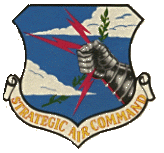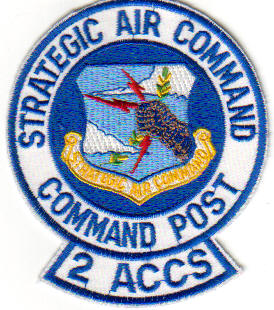The Battle Staff Operations:
Airborne Emergency Actions Officer: - A General officer that would take charge of Strategic Air Command (SAC) Forces when or if needed.
Operations Officer: - A Major/Lt Col was responsible for the mission. He/She directed the Battle Staff, Communications Team, and Flight Crew and acted as a intermediary between the crew and the Airborne Emergency Actions Officer, (AEAO) a General Officer. The Ops' Officer was a certified member of the Emergency Actions Team and a Airborne Launch Control System (ALCS) Officer.
Emergency Actions NCO: - A certified member of the Emergency Actions Team. This team would send the messages to the SAC forces if the SAC Command Center was unable.
Force Status NCO: - would track the status of all Alert and non-alert ICMBs, SLBMs, Bombers, Tankers and brief the AEAO and/or CINCSAC.
Communications Officer: - The CCO led the Airborne Communications Team and sat in the Battle Staff area next to the AEAO where they oversaw all communications to and from the aircraft. The CCO was an ALCS Officer along with the Operations Officer; and, was a member of the airborne battle staff. (Thanks Col Curtis)
The Battle Staff Plans:
Intelligence Officer: - briefed the entire battle staff on current intelligence matters, developed threat assessments, and identified emerging threats to the United States.
Planning Officer: - the second in command, headed the planning staff and advised the AEAO of the war plans available to the President of the United States.
Logistic Officer and NCO: - made sure that returning bomber and tanker forces had safe recovery bases to provide medical attention, food, and rest for the crew and expeditious repairs, refueling, and reloading for the aircraft.
The Communications Team:
Radio 1: - Was responsible for establishing and maintaining the UHF air-to-ground, air-to-air, KY-3 secure voice and Airborne Launch Control System links. The RO1 was usually the senior comm team member.
Radio 2: - Was responsible for High Frequency radios for global connectivity and being trained for RO1.
Radio Maintenance 2 or Airborne Performance Monitor: - Was responsible for monitoring the quality and and smooth operation of the A-A/A-G mux links. Also verified that ALCS data was of good quality. After the AFSAT mod the APM also monitor satellite command changes to verify that they had been accepted by the satellite.
Radio Maintenance 1: - Was responsible for all of the communications on the aircraft an expert at his craft that could troubleshoot anything from telephone systems to satellites. This person would also operate and tune the VLF/LF transmitter.
Data: - Maintained the data circuit to HQ SAC SATIN Relay. This was the primary source for record traffic. He could also establish data circuits with other WWABNCP aircraft over UHF or HF. He also operated the VLF/LF radio receivers and modulator.
AFSAT 1 & 2: - Operated the Air Force SATellite COMmunications terminal which provided clear and secure record communications with all of the WWABNCP assets and all SAC bombers, Missile LCFs and Wing CPs. An additional duty was to operate the VLF/LF Trailing Wire Antenna (TWA).



